What is the best backpacking tent or camping shelter for thru-hiking or section hiking all or some of the Appalachian Trail? Running over 2,000 miles from Georgia to Maine, the Appalachian Trail travels across heavily forested and mountainous terrain, with widely varying temperatures, both hot and cold. Frequent rain, ferocious insect life, and hiker competition for good camping spaces are all important factors to consider when selecting a tent or shelter to hike the trail.
Given the choice of single-wall and double-wall tents, q hammock, flat tarps, and shaped tarps, which one is the best to use? Can you just sleep and shelters and not carry a tent at all? What about early spring or winter hiking conditions? I’ve experienced all of these approaches while section hiking the Appalachian Trail and the answer is…it depends:
- On nighttime temperatures
- On biting insects
- On the availability of good campsites
- On your wallet
- On your tolerance for carrying bulky gear and more gear weight
- On your need for personal comfort
Let’s take a look at the different options and consider their advantages and disadvantages.
Single-Wall Tents
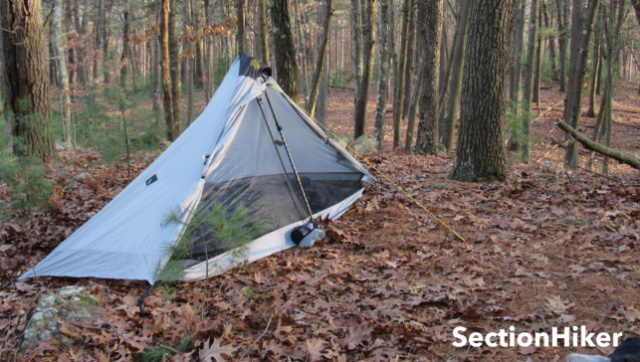
Most single-wall tents have walls that are part solid and part mesh. This improves airflow through the tent and helps to prevent internal condensation. Most single-wall tents have a fully integrated bathtub floor that is sewn to the walls of the tent, making it easy to keep the interior dry if you have to set up in the pouring rain. Many also have an integrated front or side vestibule that can be used to cover gear in bad weather. Popular models include the Zpacks Duplex, the Gossamer Gear “The One”, Six Moon Designs’ Lunar Solo, and the Tartpent’s Rainbow.
Advantages on the AT
- Easy and fast to set up
- Excellent airflow which helps reduce internal condensation
- Lightweight and compact
- Set up with trekking poles, which helps eliminate some weight
- Bug-proof and slither proof
Disadvantages on the AT
- Drafty and cold in cool weather.
- Requires good campsites with level ground and adequate space to set up
- Difficult to pitch on wooden platforms at designated campsites
Double Wall Tents

Double-wall tents offer excellent weather protection, especially in cool, windy, and wet weather during the cooler spring and autumn shoulder season months on the Appalachian Trail. They have an inner tent with a bathtub floor, mesh walls. and a separate rain fly that covers the inner tent and collects any internal condensation that may occur at night.
There are two types of double-walled tents: tents where you have to set up the inner tent before you pitch the rain fly; and double-walled tents where you can pitch the rain fly and inner tent at the same time, or with the rain fly first and then hang the inner tent under them: the Durston X-Mid-1 and the Tarptent Notch don’t require a “fast fly” footprint to set up, while the Big Agnes Copper Spur UL2 and the NEMO Hornet Elite OSMO 1 & 2 do.
Advantages on the AT
- Can be used in all three-season weather conditions, including colder weather
- Wind-proof with fully enclosed walls
- Bug-proof and slither proof
- Usually, have a vestibule for covered gear storage
- Inner tents have deep bathtub floors that can prevent flooding if water pools underneath
Disadvantages on the AT
- Can be hard to find campsites with sufficient space or level ground
- Tend to be heavier and bulkier than tarps and tarp tents although weights have been coming down.
Hammock w/ Tarp
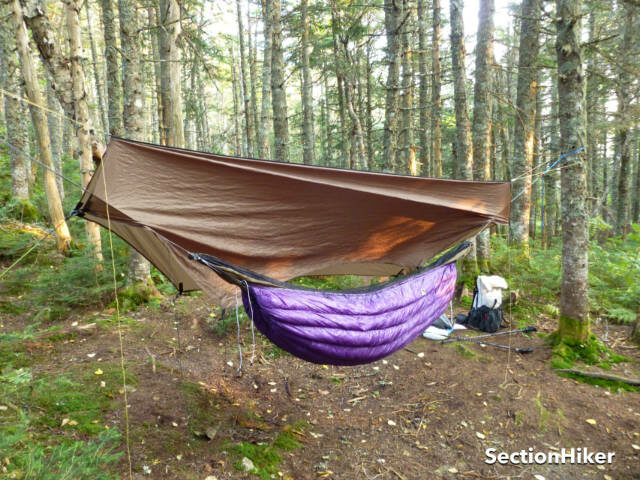
Hammocks come in a wide range of shapes, lengths, and weights, ranging from tricked-out backpacking hammocks like a Hammock Gear Wanderlust or a no-frills ENO Singlenest. The biggest advantage of using a hammock is that you can make camp wherever there are trees to hang your hammock from, which is just about everywhere on the Appalachian Trail (as long as regulations permit). That’s a huge advantage since there are a lot of places on the AT where it’s hard to find a decent place to camp: where there’s no level ground, where the campsites fill with water in the rain, or where crowded conditions require the use of stealth site.
Advantages on the AT
- Great for camping in forests, especially when good ground-level campsites are scarce
- Bug proof and slither proof, provided you add a bug net if your hammock doesn’t come with one
- Never have to worry about rain flooding your shelter floor
- Provides coverage for your gear at night and a place to cook out of the rain
- Easy to pack and set up when used with snakeskins
- Great stealth camping option
Disadvantages on the AT
- Requires extra bottom insulation and wind protection layers under 60-70 degrees which can be expensive, bulky, and heavy compared to other options.
- Not a good option when no trees are available. It happens, even on the AT.
Flat Tarps

Flat square or rectangular tarps have square, 90-degree corners and are kind of old school now. They’re worth mentioning, however, because they’re inexpensive, lightweight, and highly adaptable since they can be set up in many different shapes and orientations. They also fit very well into narrow spaces between trees and can incorporate landscape features like fallen trees and large boulders.
Pitching them is a bit of an art form and requires a lot of creativity, but can also be a lot of fun. Still, good campsite selection is important because flat tarps don’t have floors and must be augmented with an inner bug bivy or bivy sacks to provide more bug and wind protection. Popular flat tarps include the Hyperlite Mountain Gear Flat Tarp and the Hammock Gear Traverse Tarp.
Advantages on the AT
- Very lightweight and compact
- Low cost
- The most basic A-frame pitch is easy to master
- Can be pitched using trekking poles or tied to trees/shrubs
- Does not require a flat surface to pitch
- Can be configured in an infinite number of ways, including ones that incorporate landscape features such as fallen logs or boulders
- Can fit into narrow spaces between trees, unusable by other shelters
Disadvantages on the AT
- Does not provide as much cold, damp, or wind protection as a shelter with a floor that is fully enclosed on all sides
- Requires some form of bug protection such as a bug net or bug bivy
- Takes considerably more skill and practice to master setting up
- Requires that you carry more stakes and guy lines because you never know what “shape” you’ll pitch in advance
Mids and Shaped Tarps

Mids (short for pyramid) and shaped tarps differ from flat tarps in that they can only be pitched one way, as dictated by their shape. They’re essentially floorless single-wall tents without an inner tent, although most people opt to use some kind of inner shelter with them on the AT for rain and bug protection. These inner shelters are equivalent to the inner tents found in double-walled tents. Alternatively, you can use an ultralight bivy bag with a mesh cover over the face, often with some kind of UL footprint. However, when you factor in the need for an inner tent, it almost makes more sense to buy an all-in-one single-walled shelter or tarp tent since they’re the less expensive option.
Shaped tarps include pyramids, double-apex tarps, A-frames with front vestibules, catenary cut tarps, and so on. Popular models include the Hyperlite Mountain Gear Ultamid 2, the Mountain Lauren Designs Duomid, and the Zpacks Hexamid Pocket Tarp with Doors.
Advantages for the AT
- Lightweight and easily packable
- Bug and slither proof when used with an inner tent or bivy sack
- Walls can be raised for better ventilation or pitched flush with the ground to protect against rain
- Many set up with trekking poles, which helps eliminate some weight
Disadvantages on the AT
- Requires good campsites with level ground and adequate space to set up
- Difficult to pitch on wooden platforms at designated campsites
No Tent or Shelter: Just Use AT Lean-tos
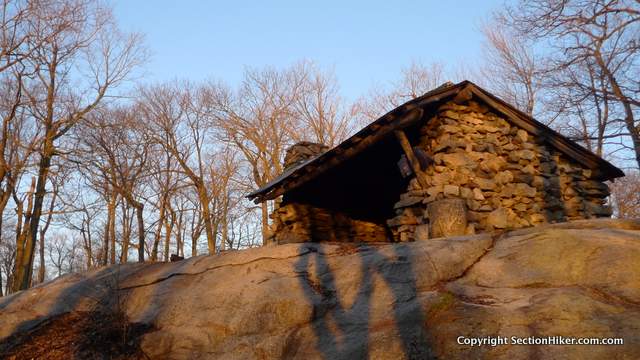
One option is to hike the Appalachian Trail or a section of it and not take a shelter at all, with the intent of just using the designated lean-tos which are spaced at 10-15 mile intervals. I’d advise against doing this because having a tent or shelter with you is an important piece of safety gear, if you have an accident and can’t go on, weather conditions pin you down, you can’t make it to a shelter each night, a shelter is already full when you arrive (first come, first serve) the shelter has resident Copperheads, Rattlers, or a wasp’s nest inside, you don’t want to share a shelter with the people already there, or it’s so disgusting and decrepit that you’d never want to sleep in it.
Bring a lightweight tent or shelter, even if you only use it infrequently. You’ll be glad you did.
Tents and Shelters for Winter Conditions
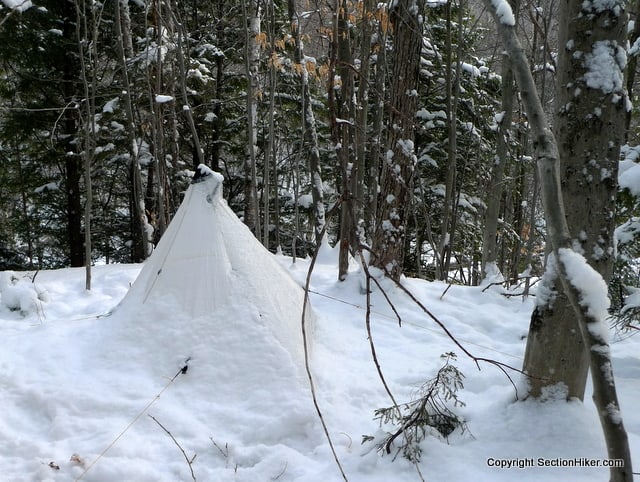
Hikers, especially thru-hikers, are increasingly taking to the Appalachian Trail in March to avoid trail crowding despite the fact that winter conditions still prevail down south. Winter adds an entirely different dimension to shelter selection on the AT since it’s nearly impossible to pound tent stakes into the frozen ground if your shelter requires them. Instead, pitching a non-freestanding tent on top of snow requires the use of deadmen (stakes frozen in place) which takes longer to set up since they need to freeze while you wait, while 12-14 hour-long nights make shelter comfort and livability more of a priority.
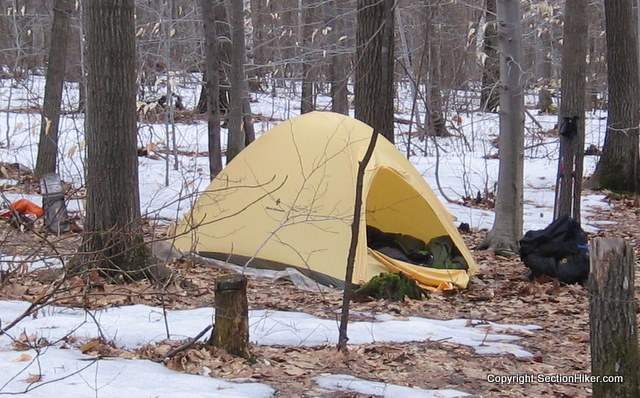
Unfortunately, none of the shelter types mentioned above is ideal for such conditions, unless you can find a good single-wall or double-wall tent which is free-standing. Free-standing, lightweight tents are relatively rare but are great in cold weather because your body weight and your gear are enough to keep them from blowing away without staking in the relatively protected campsites you find on the AT. The Big Agnes Copper Spur UL 1 or 2 are good freestanding double-wall tents that balance comfort, ease of use, and lightweight.
If you were thinking about hiking the AT in March (or earlier) and using the lean-tos since they won’t be full, I’d urge you to reconsider. Sleeping in a shelter with one open wall in freezing and windy weather where it’s so cold that you need to spend every second of a 14 hour night in your sleeping bag is the pits. There’s really no comparison between that and sleeping in a comfortable, windproof freestanding tent, even if it weighs a bit more to carry.
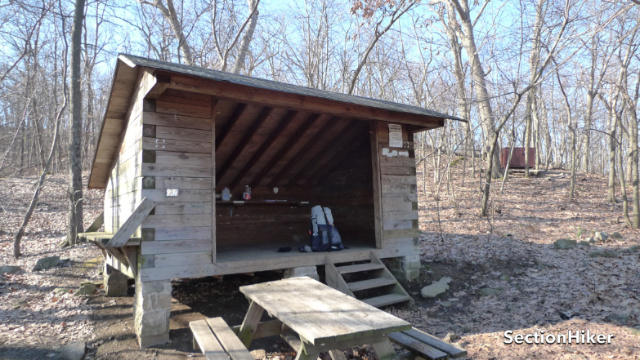
How to Decide?
I’ve covered a lot of different tent and shelter options above, but how do you decide which one to bring? I think the most important factors depend on the weather you plan to hike in and your personal comfort needs.
- If the ground is still frozen and it’s impossible to drive stakes into it, I’d recommend using a freestanding tent because you don’t have to stake it out and they can be set up in rain without the inner tent becoming wet.
- After nighttime temperatures rise consistently over 40 degrees, I believe a hammock is the best option, as long as you augment it with some bottom insulation like a foam pad or underquilt. Different amounts of insulation are needed as temperatures increase, but the ease of finding campsites and the ability to set up a dry shelter in the rain are the chief selling points of hammock-based shelter systems.
- If you don’t like sleeping in a hammock, you’ll be more comfortable switching to a tarp tent which provides better ventilation as the heat and humidity of spring and summer increase.
Whichever tent or shelter you choose, don’t forget that you have the option to hike the Appalachian Trail in warmer weather, deferring thru-hikes or section hikes to a later date when you need to carry less insulation (clothing and sleeping) and lighter-weight shelters.
SectionHiker is reader-supported. We independently research, test, and rate the best products. We only make money if you purchase a product through our affiliate links. Help us continue to test and write unsponsored and independent gear reviews, beginner FAQs, and free hiking guides.
